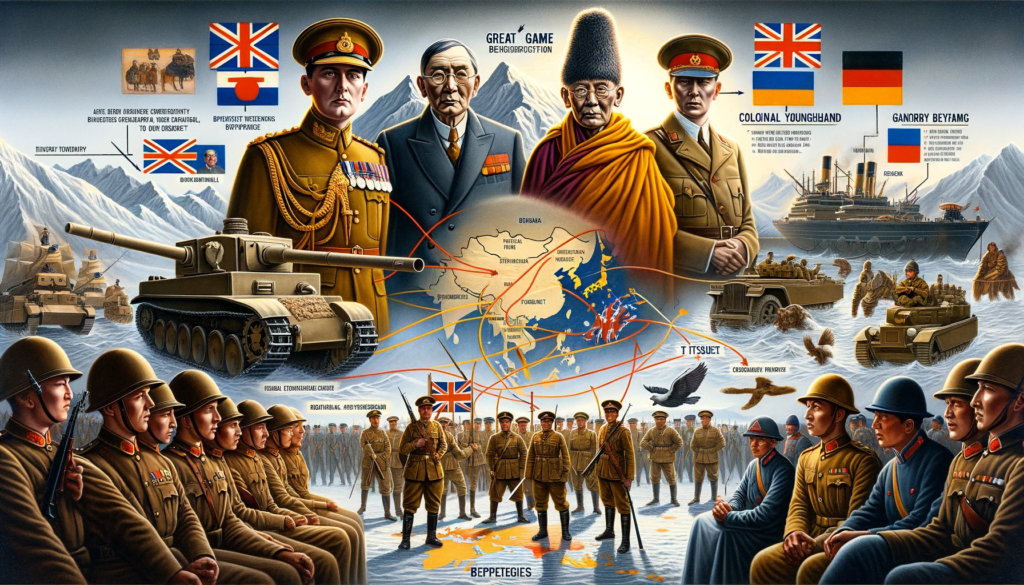The Historic British Expedition to Tibet: A Strategic Military Maneuver
In the annals of history, the British expedition to Tibet, spanning from December 1903 to September 1904, stands as a significant military campaign under the British Raj’s expanding imperial dominion. Orchestrated by the Tibet Frontier Commission, this expedition was more than a mere diplomatic initiative; it was a strategic manoeuvre, a de facto invasion by the British Indian forces with the primary aim of establishing diplomatic relations and resolving the ongoing border disputes between Tibet and Sikkim.
Geopolitical Context and British Expansion in Asia
This period marked the zenith of British expansion in Asia, having already established control over Burma, Bhutan, and Sikkim by the 19th century. Tibet, nestled in the heart of the Himalayas, remained the only kingdom free from British influence, a testament to its strategic and cultural isolation. The British expedition to Tibet was not an isolated event but part of a larger British strategy to solidify its influence in the region.

Lord Curzon’s Vision and the Russian Factor
The expedition’s roots lay in the geopolitical chess game between the British Empire and Tsarist Russia. Lord Curzon, the viceroy of the British Indian government, played a pivotal role in initiating this mission. His concerns centred around Russia’s advancing influence in Central Asia, fearing a potential Russian encroachment into British India. Despite receiving reassurances from Russia in April 1903, disclaiming any territorial ambitions in Tibet, Curzon remained unconvinced, pushing forward with the military expedition.
The Journey to Lhasa and Tibetan Resistance
The expedition’s journey was fraught with challenges as it made its way to Gyantse and ultimately to Lhasa, Tibet’s capital, by August 1904. The Dalai Lama, sensing the impending threat, sought refuge first in Mongolia and then in China. The Tibetan resistance, armed with outdated weaponry, faced the brutal might of the British forces’ modern rifles and machine guns. This unequal confrontation led to significant Tibetan casualties, underscoring the technological disparities of the time.
Diplomatic Outcomes and the Convention of 1904
In Lhasa, the British exerted pressure on the Tibetan officials, culminating in the signing of the Great Britain and Tibet Convention of 1904. This treaty marked a pivotal moment in Tibetan history, with the British withdrawing to Sikkim and securing an understanding from the Chinese government to forbid any foreign interference in Tibet’s administration.
Recognition and Legacy of the Expedition
The British Indian government officially recognized the mission as a military expedition, commemorating it with the issuance of war medals. This recognition not only symbolized the military achievements of the British forces but also highlighted the expedition’s significant role in shaping the geopolitical landscape of Asia.
The British expedition to Tibet, therefore, is a chapter of colonial history that reflects the intricate interplay of imperial ambitions, geopolitical strategies, and cultural encounters. Its legacy continues to influence the historical narratives of British imperialism and the complex dynamics of Asian geopolitics.
The Complex Dynamics Behind the British Expedition to Tibet
The Great Game and Its Impact on Tibet
The British expedition to Tibet, a critical episode in the historical “Great Game” between Britain and Russia, unfolded from December 1903 to September 1904. The underlying causes of this conflict, as historian Charles Allen observed, seemed rooted in geopolitical strategies rather than the official reasons stated by the British.
Rumors and Russian Influence
Central to the British administration’s concerns in Calcutta were rumours about China, which nominally ruled Tibet, intending to cede the region to Russia. This move would have provided Russia with a direct route to British India, disrupting the buffer states between India and the Russian Empire. The presence of Russian explorer Gombojab Tsybikov in Lhasa, and the Dalai Lama’s interactions with Russian courtier Agvan Dorjiyev, only heightened these suspicions.
Lord Curzon’s Initiative and Tibetan Resistance
Lord Curzon, the British Indian government’s head, driven by apprehension of Russian influence in Tibet, sought to establish trade agreements and reinforce British presence. Despite the Dalai Lama’s reluctance to engage with the British and China’s seeming inability to compel Tibetan participation, Curzon pushed forward. Colonel Francis Younghusband led the Tibet Frontier Commission on a mission that gradually assumed the nature of an invasion.

The March to Lhasa and Military Disparities
Younghusband’s journey to Tibet began in Gangtok, Sikkim. Despite attempts to provoke Tibetan forces into a confrontation, the expedition maintained a facade of peace. The advance towards Lhasa saw a significant British force confront poorly armed Tibetan defenders, including Gurkha and Pathan troops accustomed to mountain warfare. The Tibetan government, led by the Dalai Lama, sought to avoid conflict but was prepared to defend its territory.
Ultimately, the expedition culminated in the British reaching Lhasa. The Dalai Lama had already sought refuge, and the British, after facing minimal official Tibetan representation, imposed the Great Britain and Tibet Convention of 1904. This treaty essentially marked the end of the expedition, with the British withdrawing and leaving a lasting impact on the region’s political dynamics.
The British expedition to Tibet thus represents a pivotal moment in the history of British imperialism in Asia, underscored by geopolitical strategizing, military confrontations, and the intersection of diplomatic ambitions and cultural sovereignty.
The British Expedition to Tibet: Initial Advance and Confrontations
Preparation and Advancement of the British Army
In December 1903, the British army, under Brigadier-General James Ronald Leslie Macdonald, embarked on the expedition to Tibet from Gnatong in Sikkim. Experienced in Indian border wars, the army was well-prepared and used the initial months to acclimatize and train near the border. By March, they progressed over 50 miles, encountering the first major obstacle near the pass of Guru, close to Lake Bhan Tso.
The Massacre of Chumik Shenko
On 31 March 1904, a pivotal and tragic event unfolded, known as the Massacre of Chumik Shenko. Here, the British forces faced a Tibetan army of 3,000, equipped with primitive matchlock muskets, positioned behind a rock wall with additional defences on the slope. Despite attempts to disarm the Tibetans peacefully, a skirmish broke out, leading to a violent response from the British troops. As narrated by writers like Charles Allen and Henry Newman, this confrontation turned into a massacre, with the Tibetan forces, who were initially hesitant to engage, suffering heavy casualties.
Tibetan Resistance and British Military Strategy
The Tibetan forces, overwhelmed by the superior firepower of the British, including Maxim guns, faced a devastating defeat. Many Tibetans were killed as they attempted to flee. This battle underscored the vast technological gap between the two sides and the harsh realities of colonial warfare.
Continued Advance Towards Gyantse
Overcoming the resistance at Chumik Shenko, the British forces proceeded towards Gyantse. They encountered fortified Tibetan positions at Red Idol Gorge, where the Gurkha troops played a crucial role in overcoming the Tibetan defences. The British military, with minimal losses, managed to clear the way, reaching Gyantse by 11 April 1904. The town’s monastic complex, including the Temple of One Hundred Thousand Deities, became a point of interest for the British.

The Role of Francis Younghusband
Major Francis Younghusband, leading the mission, hoped to extend the expedition to Lhasa. Despite the massacre at Chumik Shenko causing shock and disquiet in Britain, Younghusband’s intent remained firm. The British, experiencing a period of relative calm at Gyantse, provided medical assistance to locals and engaged in community interactions while waiting for further directives.
The mission soon faced an attack at Chang Lo garrison, leading to Tibetan casualties and a few British losses. This incident, along with the reoccupation of the Gyantse Jong by Tibetan forces, solidified Younghusband’s determination to proceed to Lhasa, seeing it as a necessary step in the mission.
Conclusion and Reinforcements
The British government, responding to the situation, dispatched additional troops and resources to support Macdonald’s forces. The arrival of these reinforcements at New Chumbi marked a renewed phase in the expedition, setting the stage for the further advance into Tibet.
The initial advance of the British expedition to Tibet in 1904 highlights the complexities of colonial military engagements and the significant impact of such events on the geopolitical landscape of the region.
Alarms and Politics at Gyantse: The British Expedition’s Pivotal Moments
Strategic Encounters and Tactical Victories
During the British expedition to Tibet, significant clashes and strategic manoeuvres unfolded, particularly around Gyantse. One of the notable confrontations occurred on 18-19 May 1904, when the British forces aimed to seize a key building near Gyantse Jong and the Mission post. This operation, led by Brigadier-General Macdonald and Captain Seymour Shepard, proved successful despite fierce resistance, resulting in the capture of the building and significant Tibetan casualties.
The Shift in Command and Strategy
Amidst these conflicts, the leadership dynamics within the British camp saw a shift. Lord Kitchener, the Commander-in-Chief in India, emphasized that Macdonald should lead the Mission consistently. This decision stemmed from concerns in Simla about Major Francis Young husband’s eagerness to proceed directly to Lhasa. Younghusband, on his part, communicated his perception of Russian involvement in the Tibetan resistance, a claim that lacked substantial evidence but reflected the deep-seated geopolitical anxieties of the time.
The Siege and Assault on Gyantse Dzong
The Gyantse Dzong, a formidable Tibetan fortress, emerged as a primary target due to its strategic position overlooking the British supply routes. The assault on Gyantse Dzong was meticulously planned, involving feints and artillery bombardments to breach the Tibetan defences. The actual assault, however, encountered unexpected challenges, with the Tibetan walls proving more resilient than anticipated. The breakthrough was eventually achieved by the courageous efforts of Gurkha and Royal Fusilier troops, leading to the capture of the fortress and control of the road to Lhasa.
Valour and Recognition
The bravery displayed during the storming of Gyantse Dzong was acknowledged through military honours. Lieutenant John Duncan Grant received the Victoria Cross, the highest and most prestigious award for gallantry in the face of the enemy that can be awarded to British and Commonwealth forces, while Havildar Pun was awarded the Indian Order of Merit first class. This recognition underscored the valour and sacrifice of the troops involved in the operation.
The Controversy of Looting
Despite the military success, the aftermath of the Gyantse Dzong’s fall saw considerable looting of Tibetan monasteries, a practice that contradicted official military directives and international conventions. This aspect of the campaign, often overlooked in official narratives, highlighted the complex and morally ambiguous nature of colonial military expeditions.
In summary, the events at Gyantse during the British expedition to Tibet in 1904 encompassed a series of military confrontations, strategic decisions, and moments of individual bravery. These events played a pivotal role in shaping the expedition’s outcomes and left a lasting impact on the region’s historical narrative.
The British Expedition to Lhasa and the Treaty of 1904
Triumphal Entry into Lhasa
In early August 1904, the British expedition under Colonel Francis Younghusband triumphantly entered Lhasa, Tibet’s spiritual and political heart. They found the city devoid of its paramount leader, the thirteenth Dalai Lama, who had fled to Urga in Outer Mongolia. The British were escorted into the city by the Chinese Amban Yu-t’ai, though he professed his inability to engage in negotiations.
Negotiations and the Signing of the Treaty
Younghusband, keen to finalize the British objectives, pushed for negotiations directly in Lhasa, despite the Tibetan Council of Ministers and the General Assembly’s hesitations, particularly over the large indemnity demanded by the British. The treaty, known as the Convention between Great Britain and Tibet (1904), was eventually signed at the Potala Palace, marking a significant moment in Tibetan history. The treaty terms included the establishment of British trade in specified Tibetan towns, the recognition of the Sikkim-Tibet border, a substantial indemnity to be paid by Tibet, and the effective transformation of Tibet into a British protectorate.

Controversies and Amendments to the Treaty
The size of the indemnity and the long-term lease of the Chumbi Valley to Britain were points of contention. British officials later reduced the indemnity and eased other terms. The treaty’s provisions were revised in the Anglo-Chinese Convention of 1906, which also saw China reasserting its authority over Tibet, albeit in return for a fee to Britain.
Departure of the British and Aftermath
The British mission departed Tibet in late September 1904 after ceremonial exchanges. Though the expedition achieved its immediate objectives, it raised questions and criticisms, especially in Britain, about its justification and the ethics of the military actions, notably the massacre at Chumik Shenko.
Impact on Tibet and Historical Perspectives
The campaign had a lasting impact on Tibet, marking a significant shift in its history and relations with external powers. The narrative of the campaign and its aftermath has been interpreted differently over time, Tibetan see it as a moment of self-defence.
In conclusion, the British expedition to Lhasa and the subsequent treaty in 1904 marked a pivotal chapter in the history of British imperialism and Sino-Tibetan relations, with reverberations felt throughout the region and beyond.



















